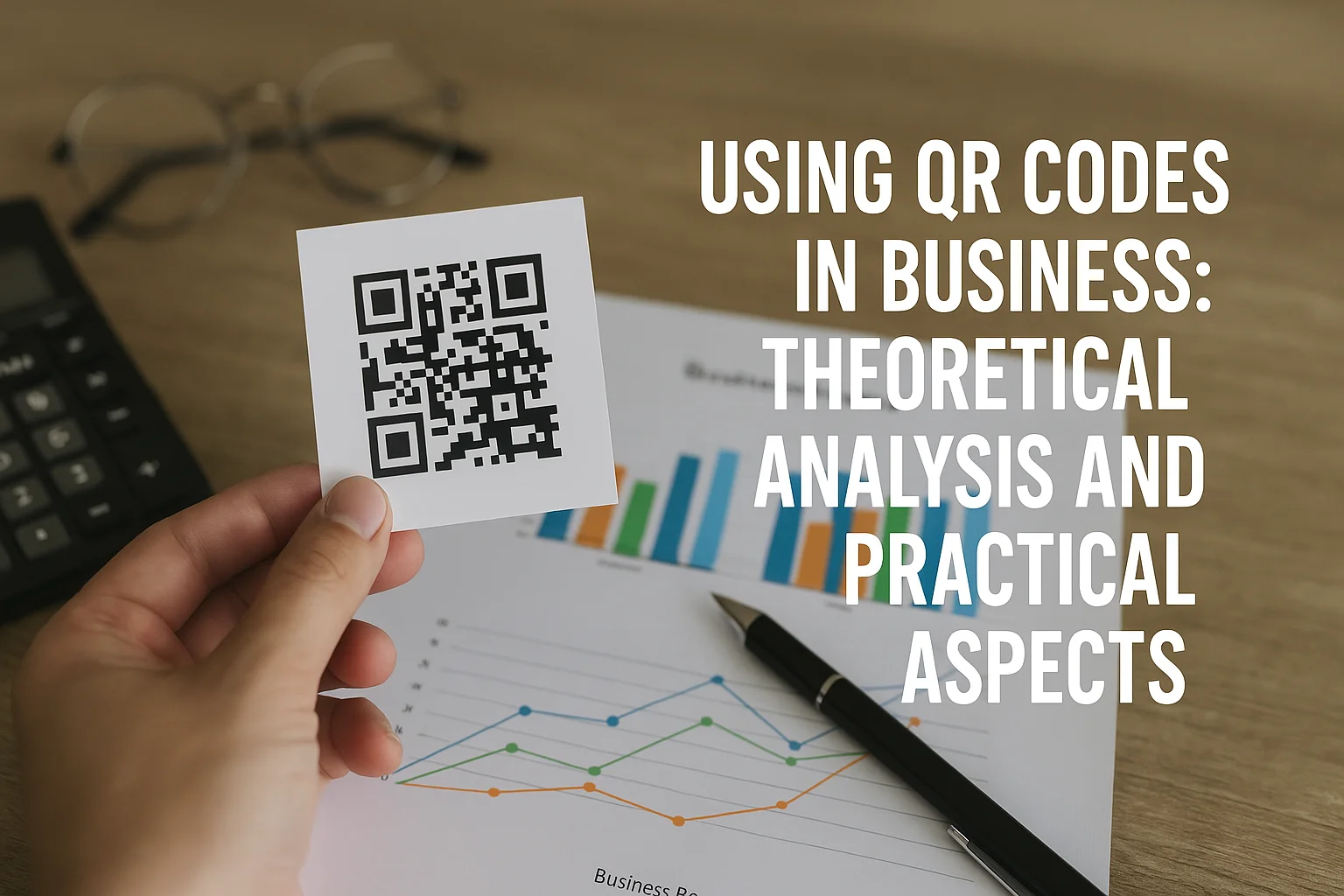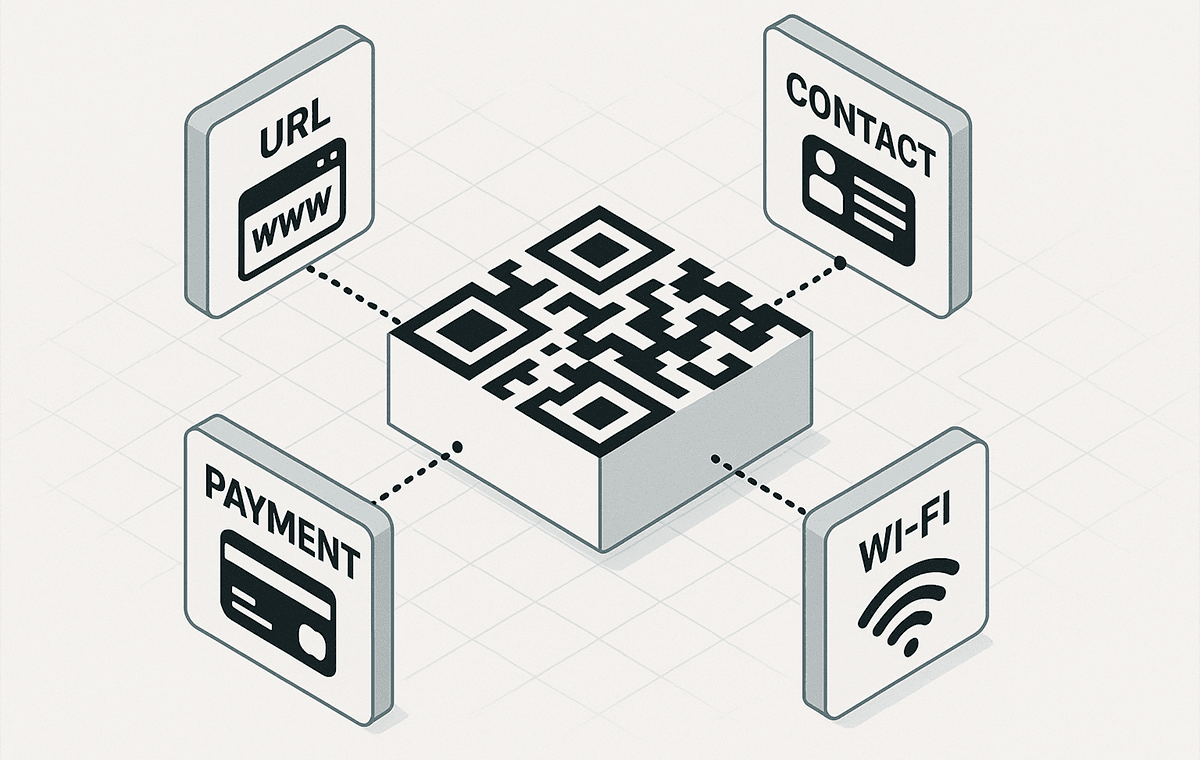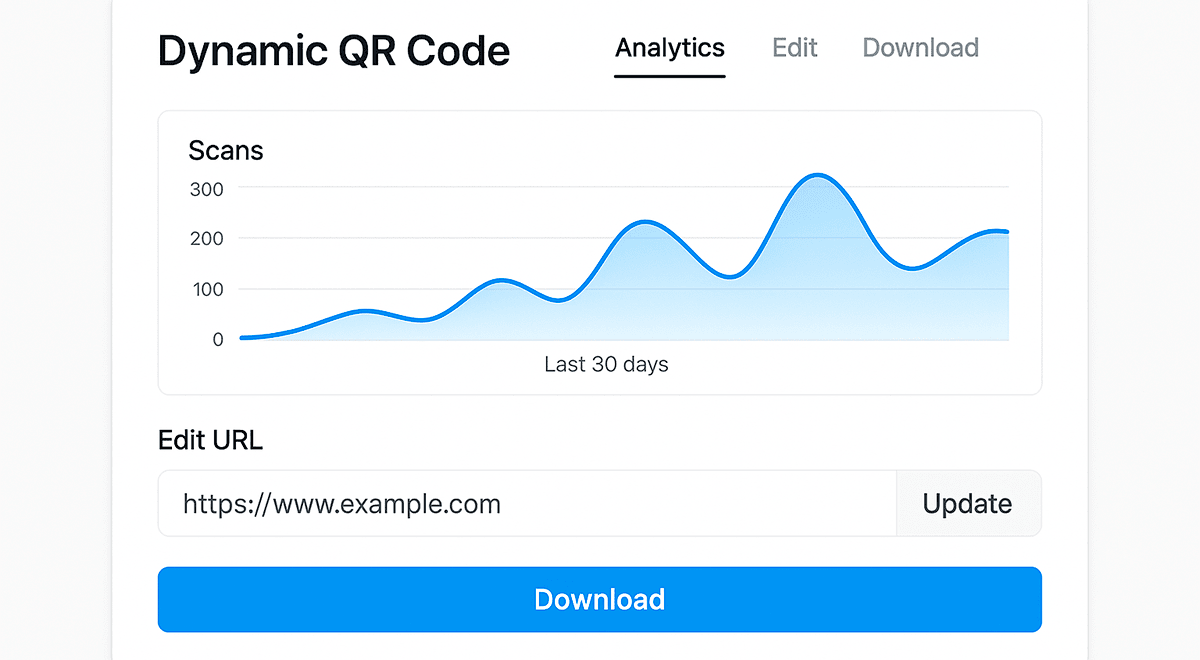
The Use of QR Codes in Business: Theoretical Analysis and Practical Aspects
In the modern digital business environment, it’s important not only to have an online presence but also to provide a convenient and fast way to engage with the customer. One such tool is the QR code — seemingly simple elements that actually serve as a full-fledged “bridge” between the physical and digital worlds.
A QR code (Quick Response Code) is a two-dimensional barcode capable of storing various types of data: from URLs and contacts to Wi-Fi, geolocations, events, or payment information. Reading it with a smartphone camera takes just a fraction of a second, and its capabilities go far beyond the usual “visit the link”.
In this article, we will not simply list the functions of QR codes. We will:
- review the theoretical foundations of QR technology and how it differs from traditional barcodes,
- explain how QR codes have become part of the business ecosystem: from delivery and restaurants to marketing campaigns and CRM,
- explain why dynamic QR codes with analytics provide a strategic advantage,
- show what effective QR code implementation looks like: UX design, branding, integrations,
- identify the most common mistakes that reduce results and how to avoid them.
If you’re just starting to explore this topic, this guide will help you understand the terms, practices, and opportunities. If you’re already working with QR codes, you’ll find useful insights for optimization.
At the end of the article — recommendations for businesses, links to related topics and practical tips on analytics. And if you’re looking for a tool to create your own code — we recommend trying our QR code generator with analytics and customization.
What is a QR Code: Technical and Practical Basics
A QR code (Quick Response Code) is a two-dimensional matrix code that can be quickly read by a smartphone camera or a special scanner. It was developed by Denso Wave (Japan) in 1994, initially to optimize the tracking of parts in the automotive industry. Over time, the technology found much wider applications.
Unlike classic barcodes, which store information only horizontally, a QR code is read in both directions (horizontally and vertically), which allows it to hold up to 7,000 digits or over 4,000 letters, as well as symbols, byte data, Cyrillic, and even emojis.
Types of data that can be embedded into a QR code

QR codes are capable of storing different types of information, enabling numerous business scenarios:
- URLs: instant access to a website, landing page, form, or social media;
- Contacts (vCard): automatic saving into the address book;
- Payments: details for Apple Pay, Google Pay, banking apps;
- Wi-Fi: automatic connection to a network without entering a password;
- Geolocation: opening a specific location on the map;
- Events (vEvent): adding an event to the user's calendar;
- SMS / Email: preparing a message or email request;
- Text / instructions: displaying a message or instructions;
Static and dynamic QR codes: what's the difference?
All QR codes can be divided into two main types: static and dynamic.
- Static QR code — the content is directly encoded into the image itself. It cannot be changed after creation. Suitable for permanent data: instructions, Wi-Fi, business cards.
- Dynamic QR code — contains a short link to an editable address. You can change the target link, track scan statistics, restrict access, and more.
Dynamic QR codes are the standard for business applications. They allow you to:
- change the content without reprinting the code (useful for promotions, campaigns, events);
- track analytics: scans, countries, browser language, time of day, etc.;
- set UTM tags for tracking conversions in Google Analytics or CRM;
- set a password, scan limit, access by time or age (for example, for 18+ content);
- use geotargeting or language personalization for the code’s destination.
💡 Example: A company runs a promotion — prints one QR code on flyers. A week later, it changes the destination page to a new offer without having to reprint anything. This is only possible with a dynamic code.
Why businesses are massively adopting QR codes: advantages that work
QR codes are no longer seen as a temporary “trend.” In many companies — from coffee shops to logistics operators — they have become part of daily business processes. Their main value is that they combine simplicity with flexibility and also allow collecting data in the offline environment.
Below is a list of key business benefits, supported by real-world use cases.
1. Instant access to digital actions
One scan — and the client immediately goes to the desired page: website, form, menu, PDF, promotion. This significantly lowers the entry barrier. For example:
- 🛒 On product packaging — QR leads to the manual or to reviews on a business card.
- 📄 In print advertising — a scan opens a landing page with UTM tags for analytics.
- 🍽 In HoReCa — contactless access to online menu or booking.
2. Business process automation
QR codes are used not just for marketing. They are now part of internal processes:
- 📦 In logistics — batch labeling, quick identification, access to documentation;
- 🏪 In retail — quick inventory, stock control, tracking movements;
- 🏥 In healthcare — linking patient cards to results or appointment records.
Thus, QR codes are not only for clients, but also for optimizing operational efficiency.
3. Marketing effectiveness and omnichannel
QR codes are easy to integrate into all promotion channels: flyers, POS materials, packaging, email newsletters. With dynamic codes with analytics you can:
- 🎯 personalize offers (promotions, coupons, UTM);
- 📊 get accurate data on the effectiveness of each advertising medium;
- 📈 collect behavioral analytics even from offline touchpoints.
💡 Example: A company runs a campaign simultaneously on Instagram, print magazines, and packaging. Thanks to separate QR codes with different tags, they can see where the traffic comes from and which audience is most active.
4. Dynamism and editability
Dynamic QR codes allow you to change the destination page without reprinting or replacing the code. You can adapt the content during a campaign without extra costs. This is especially useful for:
- ⏱ temporary promotions (changing the URL after a day, week, or hour);
- 🌍 international campaigns (redirect depending on language or geolocation);
- 🧪 A/B testing of content or UX page variants.
5. Analytics and data-driven decision making
Using QR analytics with UTM tags, you receive accurate metrics:
- number of scans, new vs. repeat users, CTR;
- geography, device type, browser, time of day;
- impact of each individual code on the target action (registration, purchase, etc.).
These data can be integrated into CRM, Google Analytics, or BI systems.
6. Contactless and convenience
Especially relevant in the post-COVID environment. Contactless access to menus, payments, registrations or feedback has become standard:
- 🙋♀️ Offline — no need to install apps;
- 🔒 With passwords or age restrictions — for safety and legal compliance;
- 🛠 In service — easy transition to filling out a form, feedback, or help.
7. Eco-friendliness and sustainability
QR codes can help reduce the amount of printed materials, which is especially important for eco-conscious brands:
- 🌱 instead of brochures — a page with all the information via one code;
- ♻ replacement of plastic cards — QR on packaging or stickers;
- 🌍 supporting digital transformation without excessive paper or logistics resources.
Where Businesses Really Use QR Codes: Industries, Examples, Cases
QR codes are a universal tool that adapts to almost any business model. They work in both B2C (retail, HoReCa, events) and B2B segments (logistics, warehouse management, manufacturing).
Below, we'll look at how specific sectors use QR technologies in their daily operations, automation, and marketing.
🛍 Retail & eCommerce
In retail, QR codes shorten the customer’s path to purchase and make after-sales support easier:
- 📦 Redirecting from packaging to a product page, reviews, or video guides;
- 🎁 Adding QR codes to loyalty programs — scan to activate a discount;
- 🚚 Real-time delivery tracking via a QR code on the box;
- 💡 Supporting promotions at POS — the client scans and receives a personalized offer.
🍽 HoReCa: Restaurants, Cafés, Hotels
After COVID, QR codes became a service standard. They save staff time and reduce contact:
- 📱 Online menus without the need for paper versions;
- 📆 Table or room booking directly from a poster or window display;
- 💳 Cashless payments — QR leads to a payment page or banking app;
- ⭐️ Collecting feedback via a QR-triggered form — fast, convenient, personalized.
Learn more in the article QR Codes for Delivery, Restaurants, and Cafés.
📦 Logistics, Warehousing, Manufacturing
Here, QR codes are used for labeling, automation of inventory, batch tracking, and error reduction:
- 🔍 Identification of each item at every stage of transportation;
- 🗂 Access to accompanying documents, MSDS, or instructions without printing;
- 🧮 Inventory with mobile scanners or employees’ smartphones;
- 📍 Route optimization — associating the code with delivery geo-data.
📣 Marketing & Advertising
In advertising campaigns, QR codes are a tool that connects offline and online and enables tracking results:
- 📑 QR codes on billboards, packaging, printed media with UTM tags;
- 🎥 Engagement with Instagram, TikTok, YouTube via QR for social networks;
- 🎁 Distributing coupons and personalized offers via QR stickers;
- 📊 Detailed analytics for every advertising channel — codes are unique for each medium.
See also: QR Codes in Marketing: How to Boost Sales.
🎓 Education, Events, Exhibitions
In event and education sectors, QR codes are used for registration, sharing materials, and feedback:
- 📝 Event registration via a QR event;
- 📄 Downloading presentations, certificates, PDFs, or the event program;
- 🎫 Entry by QR code — individual badge or digital ticket;
- 🗣 Quick feedback or surveys after the event.
🏥 Medicine & Healthcare
In the medical sector, QR codes increase accuracy, reduce paperwork, and improve access to information:
- 🧾 QR code on a medical card — for quick access to the patient’s history;
- 📲 Access to medication instructions or appointment booking;
- 📌 Links to video instructions or post-treatment information.
Branded QR Code Design: When Looks Matter
Even though a QR code is a technical tool, its visual design can significantly influence user engagement and trust in the brand. Companies increasingly personalize codes — adding logos, colors, branded frames, or animation.
This approach works best when:
- you need to attract attention at touchpoints (e.g., in offline ads or on packaging);
- it’s important to convey brand identity down to the details;
- you need to boost trust in QR as a digital element (especially for new audiences).
At the same time, it's important not to overload the code visually: maintain contrast, readability, and avoid heavy styling in critical scenarios (e.g., for payments or authorization).
🔍 More technical details, design examples, and common mistakes — in the article "Branded QR Codes: How to Design for Engagement".
QR Analytics: How Numbers Help Decision-Making
One of the biggest advantages of dynamic QR codes is the ability to track their effectiveness in real time. Marketers, business owners, and analysts receive data straight from offline touchpoints: packaging, posters, menus, or flyers.
Key metrics typically available include:
- 📈 number of scans and repeated interactions;
- 🌍 user geography and language, device type;
- 🕒 time of day, dynamics throughout the campaign;
- 🔗 CTR, UTM tags, conversions after the visit.
This data helps to:
- optimize campaigns in real time;
- compare the effectiveness of different channels (print, social media, packaging);
- adapt UX and change the code content without reprinting.
Want to dive deeper? Check out our detailed article on QR analytics, graphs, and UTM tags with practical cases and step-by-step guides.
5 Common Mistakes to Avoid When Implementing QR Codes
Even effective technology can fail if implemented with mistakes. QR codes are no exception. Below is a list of the most common business mistakes that decrease their effectiveness or harm the customer experience.
1. Using Static Codes for Dynamic Tasks
Businesses print QR codes on ads or packaging, but if the page changes, the code can’t be updated. Control is lost and the campaign becomes irreversible. Solution: use dynamic QR codes that can be edited.
2. Lack of Analytics
If you don’t embed UTM tags or connect statistics, the business cannot know if the code is working. It’s advertising “to nowhere”. Tip: integrate analytics or use services with data collection support.
3. Poor Design or Low Contrast
Overly stylized or light-colored codes may not be readable. This is critical if the code is for payment or authorization. Solution: follow contrast recommendations and test the code before publishing. More details — in our article on design.
4. Lack of Context or Explanation
If there is no explanation near the QR code (“what will happen after scanning”), users often ignore it. Tip: add a short CTA, e.g., “Scan to get a coupon” or “Menu here”.
5. Linking to Non-Optimized or Slow Pages
The user scans the code but lands on a page that doesn’t work on mobile or takes more than 5 seconds to load. This ruins the experience. Tip: test the redirection on real devices. Optimize speed and mobile usability.
Summary: How to Implement QR Codes Strategically
QR codes are no longer just a convenient way to share a link. They have become a comprehensive digital tool for automation, marketing, analytics, and building the customer experience.
Successful implementations show that QR code effectiveness depends not only on the technology, but on how exactly you use it. Below are some practical tips.
Recommendations for Business
- Start simple: use QR codes where customers already expect convenience — menus, packaging, flyers, receipts;
- Use dynamic codes: this allows you to change content, collect analytics, and run A/B tests without extra costs;
- Optimize landing pages: scanning a QR should take the user to a mobile, fast, and relevant page or action;
- Brand your codes: the design should match the company’s visual language and inspire trust (but not hinder scannability);
- Leverage analytics: not just for campaign measurement, but for creating a better customer journey.
Don’t Delay: A QR Code Is an Asset That Works
Companies that learn to strategically adapt QR codes gain a competitive advantage: they cut costs, better understand their audience, and shorten the interaction cycle.
